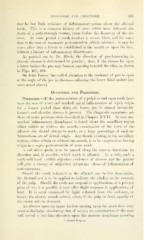Page 489 - My FlipBook
P. 489
DIAGNOSIS ASD PROGNOSIS. 487
may be but little evidence of inflammatory action about the affected
tooth. This is a common history of cases which have followed the
death of a pulp through trauma, years before the discovery of the ab-
scess. At some period a tooth receives a severe blow, and for some
time is the seat of traumatic pericementitis, which subsides : it may be
years after that a fistula is established in the mouth or upon the face,
without a history of inflammatory disturbance.
As pointed out by Dr. Black, the direction of pus-burrowing in
chronic abscess is determined by gravity ; thus, if the abscess be upon
a lower incisor the pus may burrow, opening beneath the chin, as shown
in Figs. 467, 468.
Sir John Tomes ' has called attention to the tendency of pus to open
at the angle of the jaw in abscesses affecting the lower third molars (see
cases noted above).
Diagnosis and Prognosis.
Diag-nosis.—If the pericementum of a pulpless and open tooth have
been the seat of acute and marked apical inflammation of septic origin
for a longer period than thirty-six hours pus is almost invariably
formed, and alveolar abscess is present. The diagnostic symptoms are
those of acute pericementitis described in Chapter XVII. In case any
marked inflammatory disturbance is found about the maxillary region
either within or without the mouth, examination of the teeth of the
affected side should always be made, as a large percentage of such in-
flammations are of dental origin. Any fistula existing in the maxillary
regions, either within or without the mouth, is to be suspected as having
origin in a septic pericementitis of some tooth.
A soft silver probe is to be passed along the tract to determine its
direction and, if possible, which tooth is affected. As a rule, such a
tooth will itself exhibit objective evidences of abscess and the patient
will give a history of subjective symptoms—those of inflammation of
pericementum.
Shoidd the tooth indicated as the affected one be free from caries,
the thermal test is to be applied to indicate the vitality or the necrosis
of the pulp. Should the tooth not respond to applications of a pointed
piece of ice, it is possible it may offer slight response to applications of
heat. It is next examined by light reflected from the ordinary, or
better, the electric mouth mirror, when, if the pulp be dead, opacity of
the crown will be detected.
An abscess upon an upper incisor opening upon the nasal floor may
cause a discharge simulating that of ozena; an examination of the nose
will reveal a teat-like elevation upon the mucous membrane covering
^ Denial Surgery.


